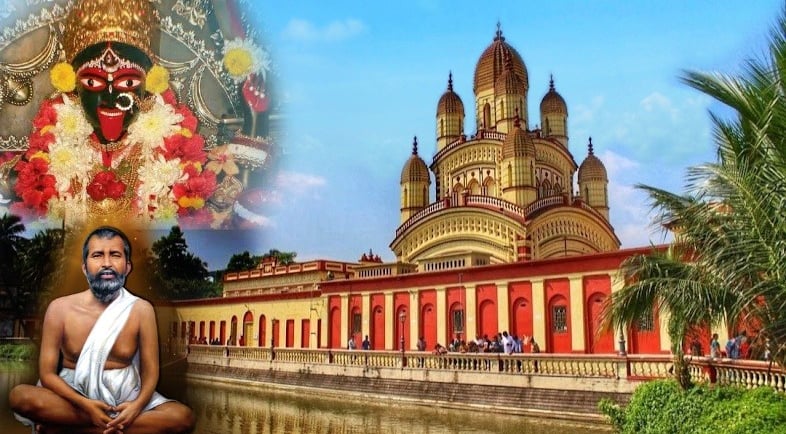Exploring the Sacred Soul of Dakshineshwar Temple: The Abode of Maa Kali
11/12/20244 min read


Historical Significance of Dakshineshwar Temple
Established in the mid-19th century, Dakshineshwar Temple holds a prominent position in the historical and religious landscape of India. Commissioned by the esteemed Rani Rasmoni, a woman of affluence and foresight, the temple was designed to be more than just a place of worship; it became a beacon of spiritual awakening for many. Rani Rasmoni's vision was to create a sacred space dedicated to Goddess Kali, emphasizing the religious fervor and socio-cultural dynamism of the era.
The temple's architectural features exemplify the quintessential style of the period, with its towering spires and intricate carvings. This architectural marvel is an amalgamation of various styles, including a fusion of the native Bengali and the traditional Hindu temple architecture. The expansive complex comprises several shrines dedicated to different deities, each reflecting unique stories and mythologies. The primary shrine dedicated to Maa Kali attracts countless devotees, offering a glimpse into the rich traditions of worship prevalent in the 1800s.
In addition to its architectural significance, Dakshineshwar Temple is closely associated with the influential figure of Sri Ramakrishna Paramahamsa, who served as the temple’s head priest for many years. His spiritual teachings and profound insights inspired a devoted following, which blossomed into the wider Ramakrishna Movement. This connection firmly cemented the temple's status as a pivotal site for socio-religious reform in India, as it became a center for philosophical discussions and spiritual exploration during a transformative period in the nation’s history.
Furthermore, Dakshineshwar Temple played an essential role in fostering a sense of community among devotees and served as a cultural hub, bringing together people from diverse backgrounds. As such, it stands not only as a landmark of spiritual significance but also as a testament to the socio-cultural evolution of India in the 19th century.
Architectural Marvels of the Temple Complex
The Dakshineshwar Temple is an exceptional example of architectural brilliance that seamlessly melds Hindu and Gothic styles, creating a distinct visual appeal. Constructed in the mid-19th century, the temple complex presents a harmonious layout that draws the eye and spirit alike. Central to this architectural wonder is the magnificent temple dedicated to Maa Kali, which stands as the heart of the complex. The temple's towering structure, adorned with intricate carvings and ornate detailing, reflects the devotion and craftsmanship of its creators.
Surrounding the main temple are twelve smaller shrines dedicated to Lord Shiva, each designed with meticulous attention to detail. These shrines contribute significantly to the overall layout, forming a circular pattern that symbolizes cosmic harmony and spiritual unity. This arrangement not only enhances the visual grandeur but also provides a serene environment for worshippers and visitors. The incorporation of these multiple shrines invites followers to experience a profound sense of connection with the divine.
The temple's location on the banks of the Hooghly River adds to its significance, as water bodies are revered in Hindu culture. The sacred riverbank serves as a place of reflection and ritual, where devotees often gather to perform their prayers and offerings. Furthermore, the architectural features of the Dakshineshwar Temple, such as the high ceilings, spacious courtyards, and inviting pathways, create a welcoming atmosphere that encourages both worship and exploration. As thousands of devotees and tourists flock to this sacred site, the elegance of its design coupled with its spiritual essence continues to captivate hearts and minds alike.
Spiritual Practices and Rituals at Dakshineshwar
The Dakshineshwar Temple embodies a rich tapestry of spiritual practices and rituals, which are vital in enhancing the ambiance of devotion surrounding this sacred site. Daily pujas form the backbone of the temple's spiritual routine, where priests perform rituals to invoke divine energy. These rituals involve offerings, chanting mantras, and lighting incense, contributing to an atmosphere of reverence that characterizes the experience for both devotees and visitors alike.
Among the special occasions celebrated with intense fervor is the Kali Puja, held annually and dedicated to the worship of Goddess Kali. This festival attracts numerous pilgrims who come together to participate in elaborate ceremonies that include the chanting of hymns and the offering of various foods to the deity. Maha Shivaratri, another significant event, celebrates the attributes of Lord Shiva, with its unique rituals attracting countless devotees and creating a vibrant atmosphere of spiritual fervor throughout the temple grounds.
Local community involvement is crucial in these ceremonies; it is not just a time for individual worship but a collective expression of faith. Devotees from various walks of life come together to contribute in various ways—be it through volunteering, preparing prasad (offerings), or participating in group chants. This communal aspect enriches the spiritual experience, fostering a sense of belonging among attendees while reinforcing community bonds.
The teachings of Sri Ramakrishna, an eminent saint associated with the temple, provide a philosophical framework that underpins many of these practices. His emphasis on self-realization and the quest for truth resonates deeply with both traditional and contemporary spiritual seekers. His teachings encourage individuals to explore their spirituality, making Dakshineshwar not only a place of worship but also a center for spiritual learning and growth that continues to attract individuals seeking deeper understanding in today’s fast-paced world.
Visitor Experience: What to Know Before You Go
Visiting Dakshineshwar Temple, an important pilgrimage site dedicated to Maa Kali, requires some planning to ensure a fulfilling experience. The temple is typically open from early morning until late evening, and the best times to visit are during the early morning and late afternoon. These periods not only help avoid the larger crowds but also allow visitors to partake in the serene atmosphere that the temple is known for, particularly during the early morning aarti, a ritual of worship involving lights and prayer.
When planning your visit, it is essential to adhere to appropriate dress codes. As a place of worship, visitors are encouraged to wear modest clothing that covers the shoulders and knees. It is recommended to avoid clothing that is too casual, such as shorts or sleeveless tops, to show respect for the sanctity of the sacred site. Footwear must be removed before entering the temple premises, which is a common practice at most Hindu temples.
Understanding local customs can enhance your visit to Dakshineshwar Temple. It is customary to offer prayers in silence, and capturing images of the deities is generally disallowed. Engaging respectfully with the local devotees is advisable; a simple greeting or nod often fosters goodwill. Take time to observe rituals that are being performed and, if appropriate, participate in them to connect more deeply with the essence of the temple.
In addition to exploring the temple itself, visitors should consider exploring the surrounding areas, including the serene banks of the Hooghly River. Attractions such as the nearby Belur Math and the scenic places along the river afford a well-rounded experience of this culturally rich region. By respecting the customs and immersing oneself in the environment, visitors can cultivate a meaningful connection to the sacred atmosphere of Dakshineshwar Temple.
